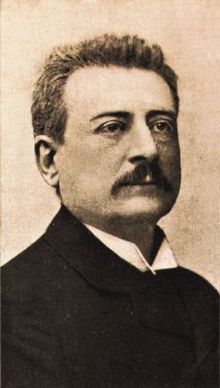Temistocle Calzecchi-Onesti
Temistocle Calzecchi-Onesti (born December 15, 1853 in Lapedona , † October 22, 1922 in Monterubbiano , Marche ) was an Italian physicist who carried out electrical experiments, which formed one of the foundations of wireless telegraphy .
Life
Calzecchi-Onesti studied physics at the University of Pisa and was then employed as a high school teacher. From 1884 to 1886 he discovered that metal shavings, which normally do not conduct electrical current in a glass tube between two brass plates, under the influence of electrical fields, such as those found in e.g. B. occur in the vicinity of an electrical discharge , reduce their electrical resistance from several megohms to a few hundred ohms . This effect was developed from 1890, after Heinrich Hertz discovered electromagnetic waves in 1888 , by the French physicist Édouard Branly at the coherer as the first technically useful method for receiving them.
Calzecchi-Onesti's reports about his discovery in the Italian journal “Il Nuovo Cimento” had received little attention from experts outside of Italy , so that the whole invention is often ascribed to Branly, although he didn't come across it until 1890. Calzecchi-Onesti proposed the device as a thunderstorm detector, and so Alexander Stepanowitsch Popow first used it in 1894, before the fritter was used a year later by Guglielmo Marconi as a receiver in the first radio receivers for wireless telegraphy .
Web links
- Short biography (Italian)
| personal data | |
|---|---|
| SURNAME | Calzecchi-Onesti, Temistocle |
| BRIEF DESCRIPTION | Italian physicist |
| DATE OF BIRTH | December 15, 1853 |
| PLACE OF BIRTH | Lapedona |
| DATE OF DEATH | October 22, 1922 |
| Place of death | Monterubbiano |
